This paper is a site visit report as part of the EPMA degree at Tsinghua University. The goal is to gain a better understanding of a freely chosen topic concerning the field of architecture in China. This report is based on visits to three significant mountain sites, and one river. Huangshan and Jiuhuashan, Anhui Province in August 2011, Huashan, Shaanxi Province in October 2010, and Yongding He, Beijing in November 2010.
Introduction: Why Landscape?
China is developing at unprecedented speed. The country has to cope with rapid social cultural change, huge economic expectations and a political system that has to adept accordingly. Architecture is a major discipline that is actively involved in the shaping of these changes.
It defines the environment we inhibit around us through the design of buildings, cities, infrastructure and landscape. Although often overlooked, these intangible changes in the development of China as a country thus also relate to a change in the physical reality that is the Chinese Landscape. I propose to asses the values, concept and experiences of traditional Chinese perception of Landscape, to critically reflect on contemporary environmental changes.
Are we still able to perceive harmony, or do contemporary rhythm alterations lead to dissonance? (What) Can we learn from the experience of the environment in traditional Chinese culture? Is there a certain balance possible between human additions and the natural environment? Can a thorough appreciation of the existing context lead to a harmonious treatment of contemporary environments? Is the experiencing of the sublime, mountain solitude and flowing waters, an inspiring catalyst for architectural mediation in the ugly landscape of reality?
Or is this all too naive and optimistic?
Chinese perception of Landscape
First of all we should establish what is Nature, what is Landscape and what is the cultural position we as humans take within these two worlds. Because the perception of nature, and the perception of landscape is very cultural specific. The ancient Chinese see the natural elements of the landscape around them as the physical embodiment of the(ir) world. This environment may be understood as ‘shanshui’, literally ‘mountains and waters’. The importance of agricultural land ownership in ancient Chinese times and the omnipresence of these overwhelming natural elements established a close bond between the Chinese people and the physical environment they inhabited. The people depend upon and are embraced by it. Which is quite different from the Netherlands, where I grew up; the Dutch are always fighting against the water; conquering it, trying to tame it, exploiting it, or getting struck by its force and unpredictability.
This respect for nature also influenced the Chinese religious beliefs (and) forming the ground on which Chinese philosophical thought is founded. In Chinese religion this lead to a worshipping of Nature and its magnificent mountains in particular. This is profoundly different from Western conceptions, where the mountain would be seen as a holy place from which to worship the divine entities, but not to be worshipped in itself or neither to be worshipped as the embodiment of something divine. And even more different from the Netherlands, where the highest point is a building, not a landscaping element..
Shanshui
So, as we try to describe the perception of landscape, the concept of Shan shui is best to use as a clear reference. As it is not only an abstract concept that describes the environment as a balance of flows and objects (water and mountains), it also shows the importance of an intellectual interpretation of Nature. And as the basis for artistic/ intellectual expression, it also shows a distillation of elements that make up the key parts of the experiencing of the harmonious interpretation of the natural landscape. The Shanshui paintings for instance, involve a complicated and rigorous set of almost mystical requirements for balance, composition, and form; based upon the reading of harmony in nature. All these paintings should have 3 basic components that together form an attractive image, but thus also relate to the translation of the experience of the landscape into a physical representation;
Paths
Pathways should never be straight. They should meander like a stream. This shows the depth of the landscape, various layers that create a sequence of experiences, rather then a straight cut path to go somewhere. The path doesn’t need to be a human creation, it can be the river, or a path along it, or the tracing of the sun through the sky over the shoulder of the mountain. The concept is to never create inorganic patterns, but instead to resonate the patterns that nature creates..
The Threshold
The path should lead to a threshold. A threshold to welcome you, to embrace your approach, to consciously experience the end of a sequence and a step into ‘the heart’. The threshold can be the mountain, or its shadow upon the ground, or its cut into the sky. The concept is always that a mountain or its boundary must be defined clearly.
The Heart
The heart is the focal point of the painting and all elements should lead to it. The heart defines the meaning of the painting. The concept should imply that each painting has a single focal point, and that all the natural lines of the painting direct inwards to this point. (3)
The integration of these three typological elements leads to an overall pleasing image, that embodies an integration of perception, experience and the qualities found in the natural landscape. This physical representation becomes a tool to express a desired harmony; and creates a medium to share ideals.
Mountain significance
Although the concept of Shanshui is rather abstract and/or intellectual and although understood by the common people, the creators of these paintings where all well-respected scholars and artists. The other intangible aspect that marks the significance of natural landscaping elements, which was open to be practiced by everybody in the empire, is through the link with religion. And this especially accounts for the mountains.
The origin of the Chinese worship of mountains is unclear, although it is clear that from early on in there has been a strong affection towards mountains and they were often treated with a ‘mixture of reverence and dread’. (5)
Architecture meets landscape
Besides the interpretation of nature through arts and religion, the Chinese Culture also has strong ideas on how to appreciate the natural landscape in its totality. It was found to be fundamental for individuals to experience its natural qualities consciously by traveling through it. As a way to experience the harmonious quality of nature, and also as a way to experience a route of transcendence, towards enlightenment. To enhance this conscious experience, there is a crafted route of carefully placed (architectural) interventions to create a sequence of pure and distinct landscape experiences. To enhance the intended progress to enlightenment and to establish an experience of sublime, beyond beauty, there is a path, a core plot of architectural additions that organize spaces experientially. These elements add significance to particular places along the path to frame, structure and layer one’s journey through the valley. To create a threshold and to express a state of harmony; man-made elements that strengthen natural religious characteristics. We can identify;
Emotive landscape; a route that is able to arouse intense feelings of natural compassion.
Surprising landscape; thresholds of experiences to consciously experience the end of a sequence; Landscape can make things hides but it can also reveal.
Respected landscape; passing through the landscape you are struck by its beauty, enforcing your respect.
The sequence of spaces defines a conscious perception of the landscape. Each architectural intervention is thus highly contextual, defining a unique experience as one ascends the route.
Three Typologies
Within China there are three distinct mountain types. To understand how the relation between landscape, architecture, harmony and experience is perceived amongst a variety of mountain sites I chose three distinctly different mountains to describe and explore. Although these three mountains share a set of common grounds (stone, water, forests for instance); in line with the topic of my paper I would like to introduce them as different ‘mountain typologies’.
The type of a mountain is normally defined by its geological characteristics. But, because mountains play such an important role within the Chinese culture, we can define the main type of mountains according to their social-cultural appropriation:
Buddhist – Four Sacred Mountains
Taoist – Five Great Mountains
Non-religious – Top Scenic Spots/ Huang Shan
We can see that the Sacred Mountains of China can actually be split into two typologies, one associated with Taoism and the other with Buddhism. The group associated with Taoism is known as the Five Great Mountains whereas the group associated with Buddhism is referred to as the Four Sacred Mountains of Buddhism. The third group, or ‘non-religious’, can still be considered part of a transient experience, as also in Confucianism the going into Nature was regarded as a reference to the transient nature of man as Confucius wrote in the Analects;
Buddhist
While many of China’s mountains have become revered over history, four in particular are believed to be especially sacred. Mountains are where heaven and earth touch and in this vein, Chinese believe that bodhisatvas (the Buddhist disciples who have reached nirvana but come back to earth to help mortals on their own paths to enlightenment) dwell in the four sacred mountains. Over time, Buddhist monasteries have built large complexes in the mountains and pilgrims from all over China visit these sacred peaks. While most were ravaged during the cultural revolution, a revival in Buddhist traditions and tourist dollars have helped to begin restorations and renovations in many of the sacred sites.
Taoist
According to Chinese mythology, the Five Great Mountains originated from the body of Pangu, the first being and the creator of the world. Because of its eastern location, Taishan is associated with the rising sun which signifies birth and renewal. Due to this interpretation, it is often regarded as the most sacred of the Five Great Mountains. In accordance with its special position, Taishan is believed to have been formed out of Pangu’s head. Hengshan in Hunan is believed to be a remainder of Pangu’s right arm, Hengshan in Shanxi of his left arm, Songshan of his belly, and Huashan of his feet. (8)
Non-religious/ Huangshan
THREE MOUNTAINS
Hua Shan (Taoist)
Huashan is located in Shaanxi Province, about 120 kilometres east of the city of Xi’an in West-Central China. Also known as Xiyuè, Western Great Mountain, it is one of China’s Five Sacred Taoist Mountains, and has a long history of religious significance. Originally classified as having three peaks, in modern times the mountain is classified as five main peaks, of which the highest is the South Peak at 2154,9m. (10)
Spread over the mountain range there is a variety of temples and other religious structures (such as small nunneries and pavilions) on its slopes and peaks. At the foot of the mountain, at the start of the walking trail is the Cloister of the Jade Spring.
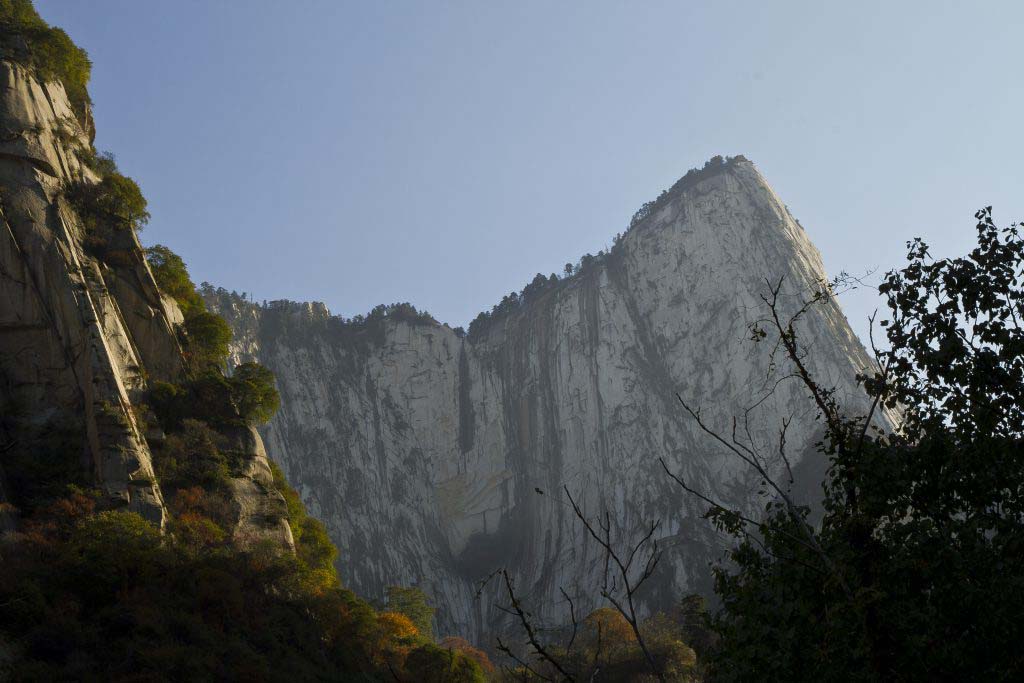
History
As early as the 2nd century BCE, there was a Taoist temple known as the Shrine of the Western Peak located at its base as Taoists believed that the mountain is the realm of a god from the underworld and the temple at the foot of the mountain was often used for spirits mediums to contact the god and his underlings.
Because of its inaccessibility to the summit Huashan only received Imperial and local pilgrim; and was not well visited by pilgrims from the rest of China. Unlike Taishan for instance, which became a popular place of pilgrimage. Although more and more tourists visit Huashan these days, it is still quite hard to reach and the visiting numbers are not comparable to either Taishan, or Huangshan.
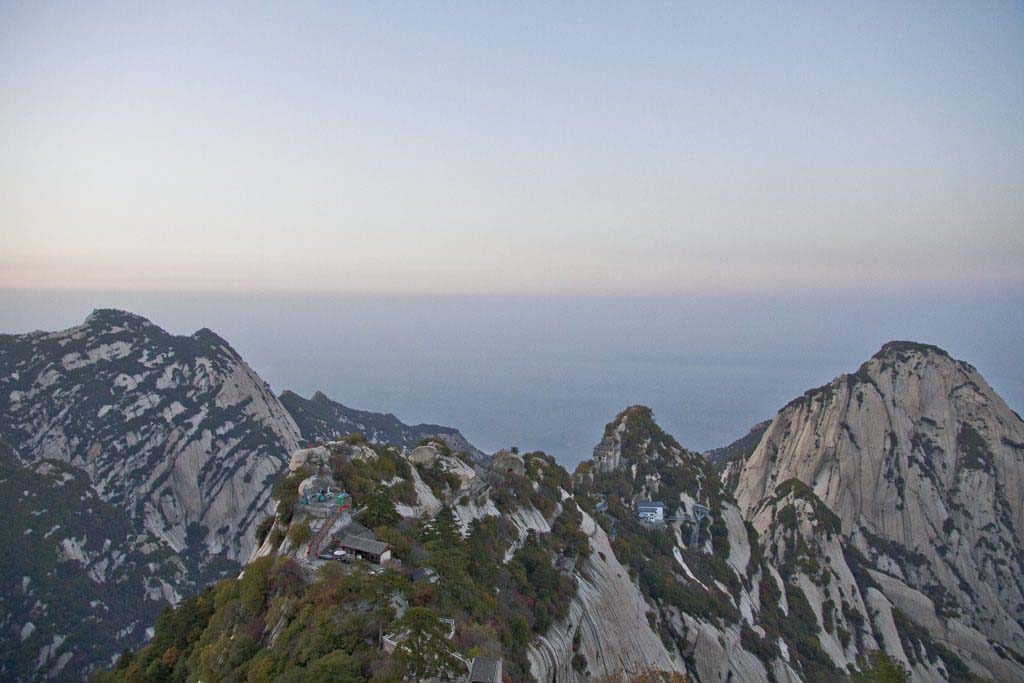
In history Huashan also was an important place for immortality seekers, as many herbal Chinese medicines are grown and powerful drugs were reputed to be found there. In addition notable Chinese historical figures received revelations on Huashan, such as Kou Qianzhi (365-448), the founder of the Northern Celestial Masters, as did Chen Tuan (920-989), who spent the last part of his life in hermitage on the west peak. In the 1230s, all the temples on the mountain came under control of the Taoist Quanzhen School. In 1998, the management committee of Huashan agreed to turn over most of the mountain’s temples to the China Taoist Association. This was done to help protect the environment, as the presence of taoists and nuns deters poachers and loggers. (11)
Landscape elements
Ascent and routing
Ascending Hua Shan the carefully constructed route is guided alongside waterways, through gates, underneath rocks, climbing cliff edges and passing temples, to prepare you to witness the beauty on the top as profoundly as possible. In total there are three ways up the mountain. They all lead to the North Peak, the first of five summit peaks. The other four peaks are representing the remaining for directions (East, West, South and Center) and are connected by a sort of circular pathway around the cliff face.

Two of these options start at the eastern base of the mountain, at the cable-car terminus. You can either choose to take a scenic 10-minute cable car ride from there, or walk your way up under the cable car route. The third option is to start the walk at Hua Shan village, at the Jade Fountain Temple. This is the most challenging route as it is the most physically demanding; steep stairs, narrow and almost vertical sections.

But, the scenery is spectacular and this route will thus offer the best reward as the intensity of the journey is coupled by a feeling of pride and awe towards an experience of the sublime. The ascent starts at a temple complex and then goes along a gentle water stream into the valley, after you pass the official gate. You then start to go up as you approach the north peak from its western side. The road is marked by natural points of significance, such as steep cliffs, large pieces of stone spanning the route above your head or large panoramic vistas of the surroundings; and of course the occasional food-supply store that offers noodles and other refreshments. The summit route to Hua Shan is often described as being the most dangerous of all the famous mountains in China, because its strenuous, steep and sometimes not fully safeguarded, with nothing but a steel chain to hold onto.
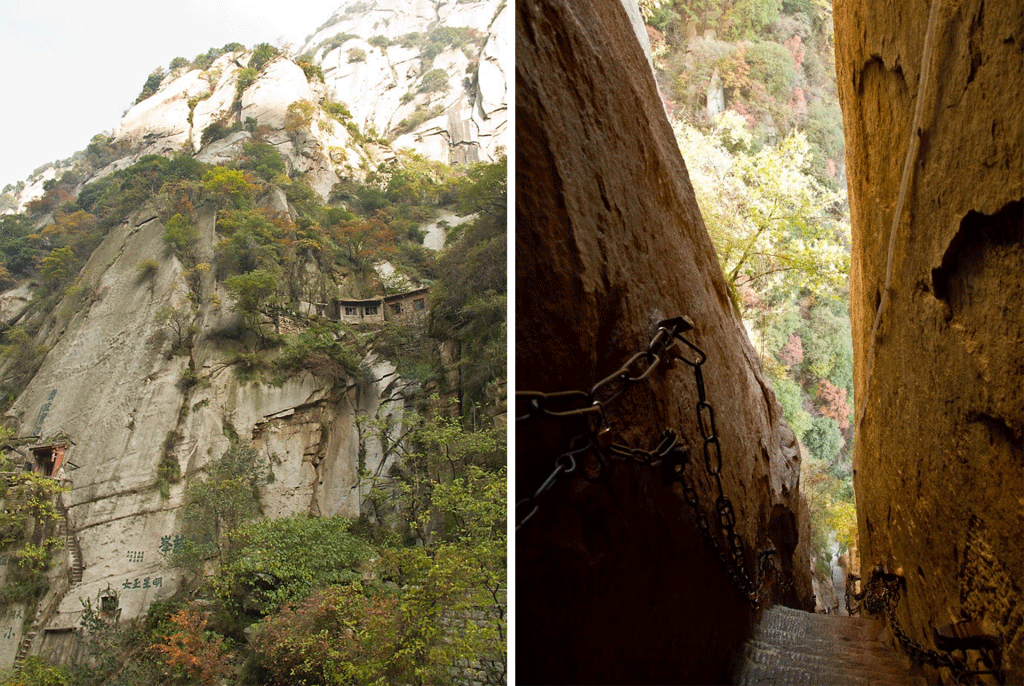
To complete a true experience of Huashan mountain, preferably preceded by an overnight stay in one of the small courtyard guesthouses in the summit area, one should include the experience of seeing the sun rise from the East peak to end your journey of transcendence.
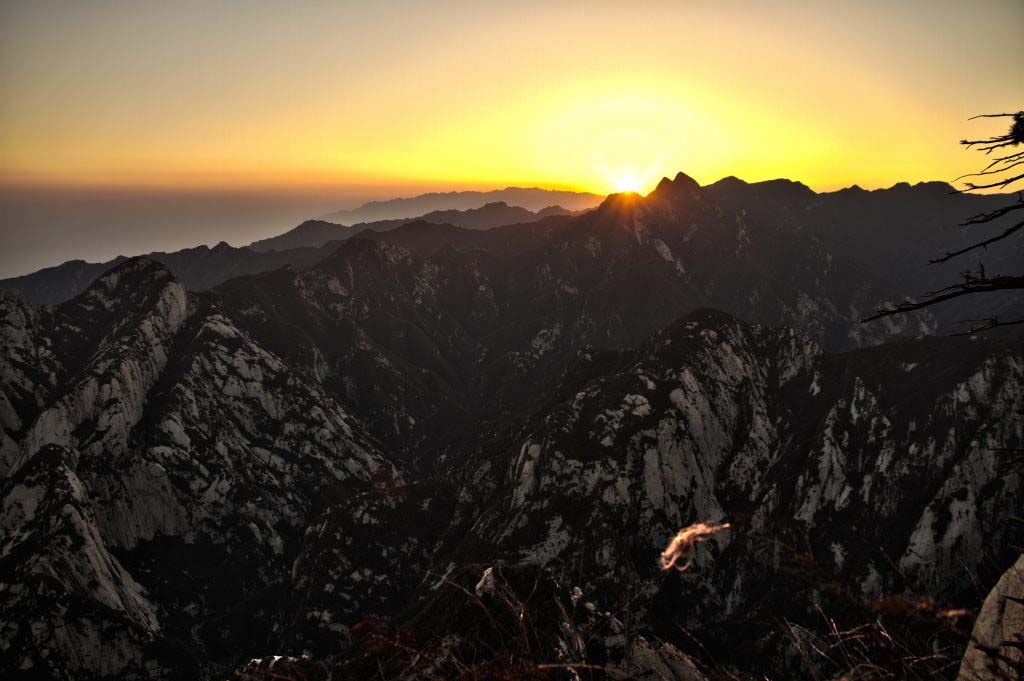
Jiuhua Shan (Buddhist)
Jiuhuashan is one of the four sacred mountains of Chinese Buddhism. It is located in Anhui province, a few hours driving southwest from Nanjing, and is famous for two reasons, it rich landscape and ancient temples. Interesting to note at Jiuhuashan is that not only the mountain range itself, or the peaks behold a sacred character. There is also a large concentration of historic and religious sites
Many of the mountain’s shrines and temples are dedicated to ‘Ksitigarbha’, because the mountain’s 99 peaks form the domain of this Lord of the Underworld, who is known as Boddhisattva ‘Dizang’ in Chinese pinyin. Buddhists often visit Jiuhuashan to climb to Greater Tiantai peak, which is regarded as Jiuhuashan’s most important peak, although it is not the tallest.

History
Jiuhuashan was identified in the 8th century as a worshipping place for Dizang by the Korean Buddhist disciple Kim Kiao Kak (Jin Qiaojue). He came to Jiuhuashan in 719 AD and retreated himself for 5 years. He died at 99 years of age, with his mortal body staing intact. Because he was very similar in appearance to Dizang Buddhisattva, the monks there believed Dizang Boddhisattva was reincarnated in him, as a result, Jiuhua Mountain became the dedicated place for Dizang Boddhisatva. During the golden periods of the Ming and Qing dynasties, there were as many as 360 temples and between 4,000 to 5,000 monks and nuns. At present 78 temples remain that house a large amount of statues, stone steles, Buddhist sutras and other relics. These temples are not all ancient structures, as the current assembly of buildings is a mixture of recent, newly build (or still under construction) temples and facilities, existing ancient structures and renovated objects. This due to recent increase in visiting numbers that have demanded a larger (religious) infrastructure to deal with the influx of people.
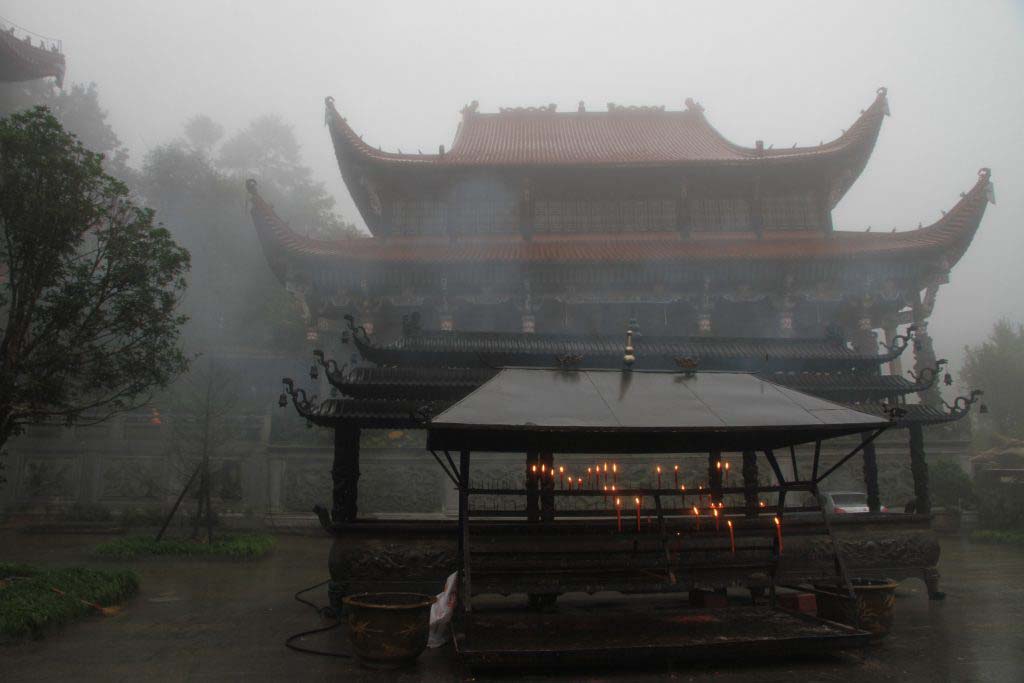
Landscape elements
Jiuhuashan covers an area of 120 square kilometers with 99 peaks and a total of 18 scenic spots. The ‘Heavenly Terraced’ or Tiantai-peak is the most important peak with an elevation of about 1,300 meter. It is a good place to view the sunrise, sea of clouds and the surrounding mountain peaks, although on my visit everything was shrouded in clouds, rain and mist and I could sometimes not even see where the steps would continue. The highest peak of Jiuhuashan is Shiwang Peak, about 1,342 metres above sea level. Because of its astonishing landscape and pleasant climate during the warm summer monts, Mt. Jiuhua is considered one of the foremost summer resorts in China.

So, besides the mountain being an important religious destination, the landscape around Jiuhuashan is also widely honored for its enticing beauty. It is full of streams, impressive rock formations, waterfalls, caves, old pines and bamboo forests. Most of the original temples are carefully embedded away within this landscape scenery or placed in the secluded, quite landscape of water, pines and bamboos around the mountain. Huacheng Temple for instance, the oldest and most important temple, lies in mid Jiuhuashan, enclosed by the mountains, with Furong Peak to the south, Shenguang Ridge to the west, White Clouds Mountain to the north, and cliffs to the east. (13)
Ascent and routing
The routing towards the summit of Jiuhuashan is an assembly of pilgrimage destinations that has two main sections. The first section takes you from the tourist information center/ bus-station, by either bus or taxi, half way up the mountain range to Jiuhuajie. “or, as locals say, at roughly navel height in a giant Buddha’s potbelly” (14) During this short trip you pass (and can stop at) the first temples (see on page 18) and the buddhist academy. The routing is not so much based upon the interpretation of key-landscaping elements but starts as a purely religious sequence of spiritual rituals and places to accommodate this. Worshippers hold sticks of incense to their foreheads and face the four directions to show their devotion at every major temple. They also kneel and pay honor to the various boddisatvas and deities by citing prayers or teachings and offering fruits and candles.
After entering the town of Jiuhuajie most people continue their journey at the Zhiyuan Temple, a highly esoteric place that is filled with worshippers, candle lights and the smell of incense. A series of small buildings and courtyards lead to the Grand Hall of Zhiyuan Temple that stands 43m high. A horizontal board inscribed with gilded “Grand Hall” by Yu Youren, a famous calligrapher, hangs over the entrance. In the center of the hall, surrounded by pilgrims take take part in buddhist teachings, is a lotus throne, on which three large Buddha sculptures are located, each about 6-7m high and all gilded, Tathagata in the middle, Amitabha on the left, and “Medicine Master” on the right. They are the biggest of all the Buddha’s in the Jiuhua temples. On either side of the central throne stand nine 3m-high images of Arhat.

From Zhiyuan temple you can continue on to Huacheng Temple, the oldest and most prominent temple in Mount Jiuhua that marks the place with a history of more than 1,500 years. The temple was said to be started as a small Buddhist temple in the Jin-Dynasty (around 401 AD) by an Indian monk. During Tang Dynasty it was renamed ‘Huacheng’. Then in 794 AD the Korean monk Jin Qiaojue, mentioned earlier, died at 99. Fellow monks regarded him as the incarnation of Ksitigarbha or Dizang the temple and ever since Huacheng Temple was dedicated to Dizang. This temple and this event thus became the start of developing Jiuhuashan into one of China’s most sacred Buddhist sites.
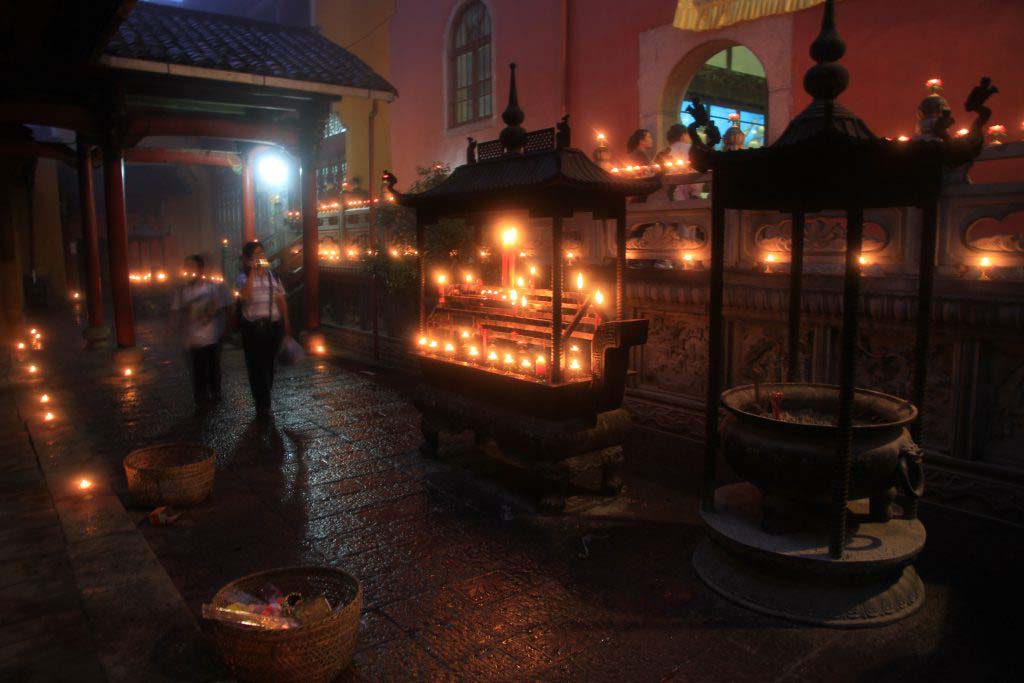
From the Jiuhuajie village then are two ways to get to the mountain summit; you either start to hike up the ridge behind the Zhiyuan temple or you can take the cable car from the station close by. From the top you can then walk south to the Huixiang pavilion, with a recently constructed seven-story pagoda. From there you can find your way (walking or cable car again) to Tiantai Zheng peak and Tiantai Temple, as ‘the heart’ of the journey, where a statue of the Dizang Buddha is located in the Dizang hall.
The temple actually sits across a dent on the peak formed by two hills; the dent being leveled with a large stone base that is about 8 meters in height to achieve a flat building podium. The building faces south, of course, and has a stepped podium in front on which the incense burners are placed.
The last part of the ascent is quite steep and there is an experience of tranquility when one reaches the flattened podium that defines the temple’s ground on the mountain.
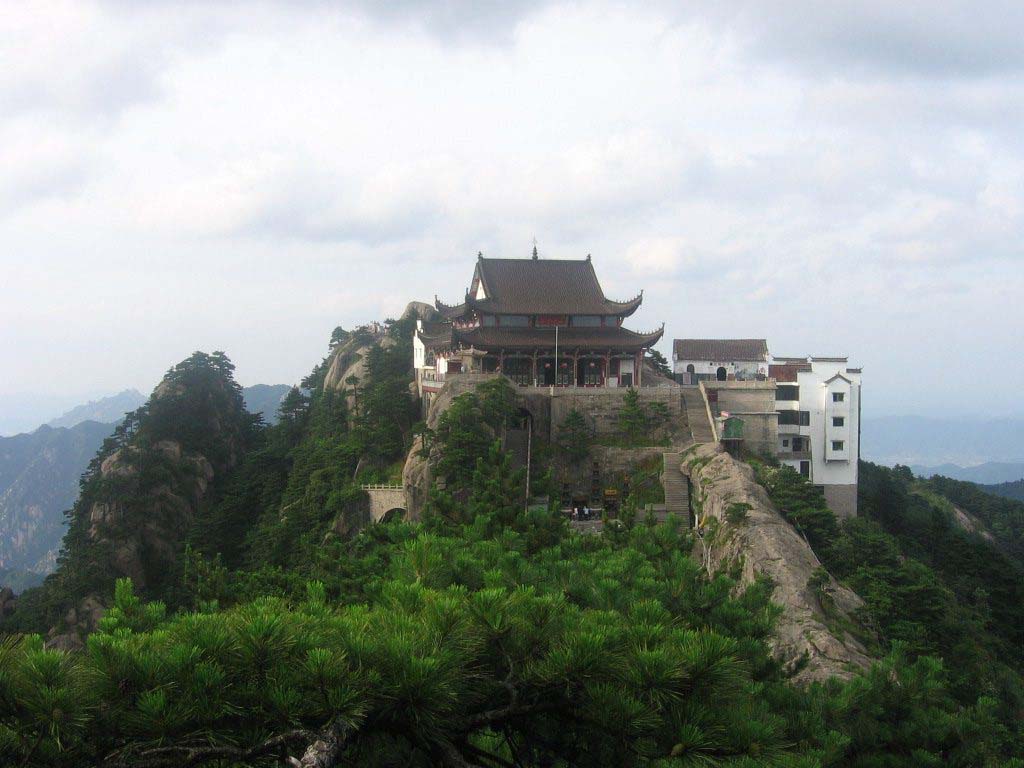
Huang Shan (Non religious)
Huangshan is a mountain range in southern Anhui Province, in Eastern China; not far from Hangzhou. When literally translated from Chinese ‘Huangshan’ means ‘Yellow Mountain’. Though the meaning of ‘yellow’ does not necessarily indicates a yellow color, as yellow is often used as a representation for one of the five sacred elements or cardinal directions. It was acclaimed through art and literature during a good part of Chinese history (e.g. the Shanshui ‘mountain and water’ style of the mid-16th century). Today it holds the same fascination for visitors, poets, painters and photographers who come on pilgrimage to the site, which is renowned for its magnificent scenery made up of many granite peaks and rocks emerging out of a sea of clouds.
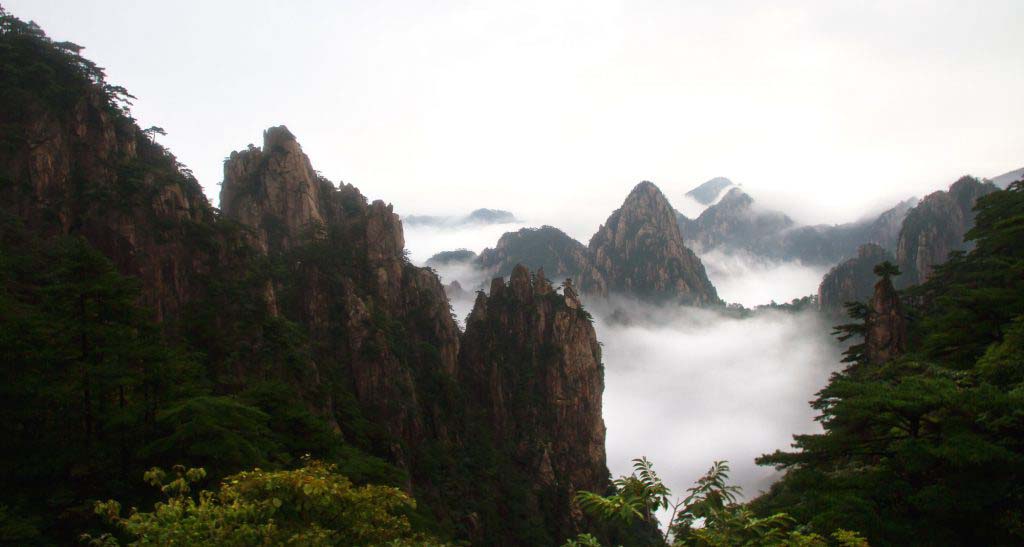
The Huangshan area is well known for its scenery, sunsets, stunning granite peaks, the famous Huangshan Pine tree, and views of the clouds from above. Especially these clouds are noteworthy, as they form shape seas of rolling clouds that hide the mountain valleys and leave the peaks floating as islands. This phenomena is called ‘yunhai’.
Huangshan is one of China’s earliest massive tourist destinations, as it ranks among the first national key scenic spots proclaimed by the State Council in 1990 and it now attracts over 15 million people annually. It was listed as a Unesco World Cultural and Natural Heritage Site in that same year. Besides being a tourist destination it is also a frequent subject of traditional Chinese paintings and literature, as well as a favorite amongst modern photography and a subject for contemporary research in the fields of habitat/ ecology/ local flora and fauna.
History
Huangshan was considered a significant source for intellectual and artistic inspiration throughout Chinese history, which paved the way for the establishment of a Huangshan culture, resulting in a rich legacy of art and literature. The mountain range is considered to be a prime example of classic Chinese scenery, as typified in traditional Shanshui landscape paintings. But, it was only after an imperial order during the Tang dynasty that made the area more accessible and had it given the name Huangshan (Yellow Mountain). From this point on, poets, literary scholars and numerous other celebrities were among the many visitors, and by the Yuan dynasty, 64 temples had been constructed on the mountain. Although Huangshan was not officially listed as a sacred mountain in the same way as Huashan or Jiuhuashan were conceived, the creation of temples were an expression of admiration for the sublime experience of the mountain range.
During the Ming dynasty, in 1606, Monk Pumen came to Huangshan and built Fahai Meditation Temple and Wonshu Temple, connecting them by steps cut into the mountain. Paintings and drawings of the mountain appeared as early as the mid-16th century. (15) Currently there is little religious activity left on the mountain, there is the Ciguang Temple at the bottom of the western steps (see picture below), which is one of the few surviving temples, but it halls have been converted to the Huangshan Visitor Center, showcasing a large landscape model of the site, adjacent buildings function as office space, toilets, etc.

All in all the contemporary experience of Huangshan is drastically different from the time of the great poets and painters, as the mountain progressively became a massive tourist destination. It has been made easily accessible through cable-cars and the facilities on top of the mountain have been radically uplifted (you can find a ‘Bank of China’, several 4/5 star hotels, a China Mobile store, supermarket, etc). But as the lonely planet puts it
And these days young lovers bring up padlocks engraved with their names, attach them to the railings in the hope of an eternal bond.
Landscape elements
When talking about the landscape elements in the Huangshan scenic area, one cannot overstate its beauty and the overall inspiring environment; it is not only an impressive natural area, but is also known as ‘the loveliest mountain of China’, a kind hearted place. It also has an interesting but complex geological history. The range is composed of sediment material that was uplifted from an ancient sea about 100 million years ago; the mountains themselves were carved much more recently by glaciers during the Quaterny period, starting about 2,6 million years ago.
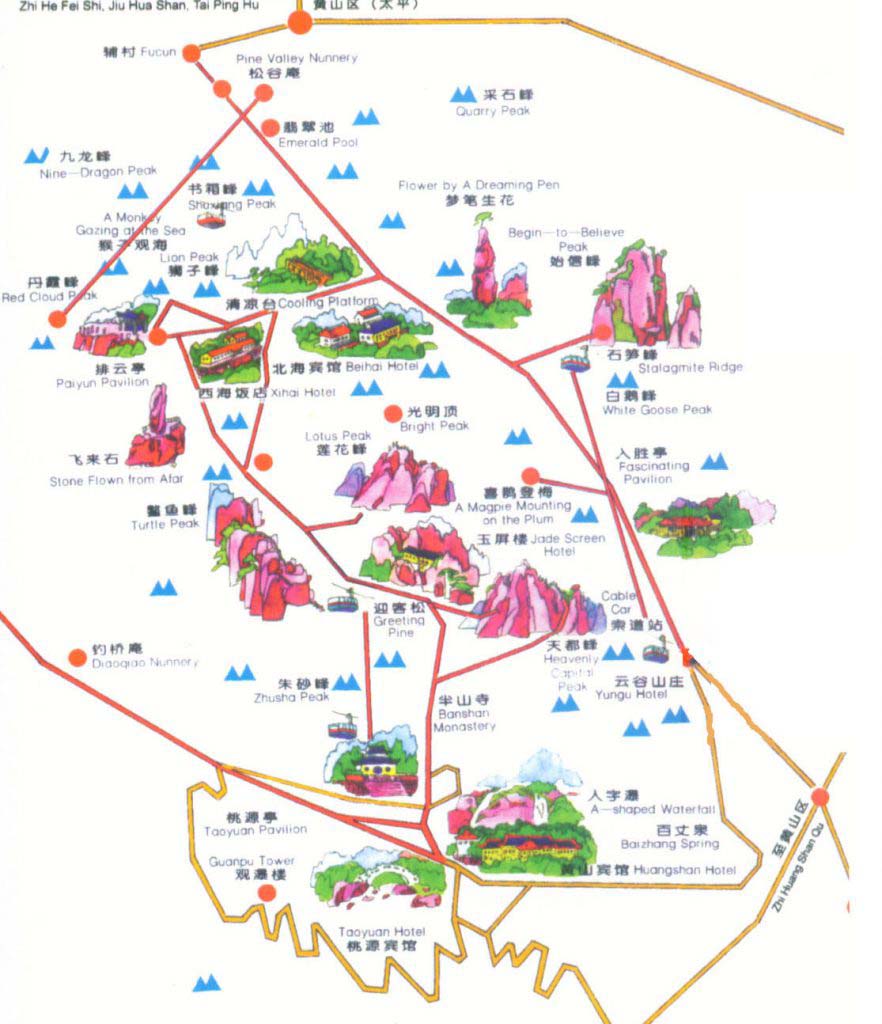
Because of the quite recent erosion, the area features jagged edges and numerous imposing peaks, of which there are three most familiar ones (Lotus Peak, Heavenly Capital Peak and Bright Summit Peak). Aesthetically, the site presents an almost unique spectacle, with its combined attraction of high mountains, forests, lakes, stepped lakes and waterfalls; representing all the elements that should be present in a mountain scenery, according to Chinese traditions (sea of clouds, water, jagged edges, waterfalls, etc).
Huangshan also has a very vivid character. It changes its moods throughout the day, heavy rains, fog and sunshine can happen simultaneously in different areas; throughout the seasons; and throughout ones ascent to the top. The rich variety of colors for instance, many of the lakes having clear blue, turquoise or green waters, while in autumn many of the leaves turn a range of rich colors and the best impression is said to be in winter, when the mountain is covered in snow-white.
And for those who are not convinced that such a place can actually exist, there is the ‘Beginning to Believe-Peak’, coined after someone arrived at this peak and wrote a short poem in which he stated that he never had thought such a place could exist on earth;
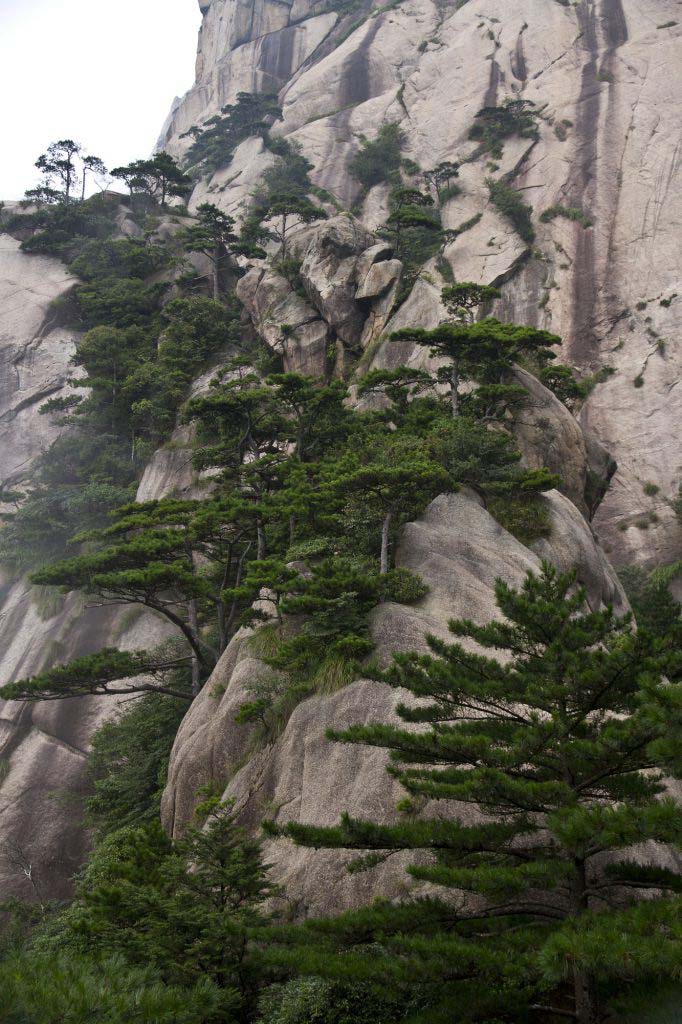
Forests of stone pillars are plentiful; there is a hot spring area found at the South-western base of the mountain and forests of trees cover more than half of the site. Predominantly evergreen moist forest occurs between 600 m and 1,100 m; there is deciduous forest from 1,100 m to 1,800 m, and alpine grassland above the tree line.(18) The Huangshan Pine Tree is unique to this area, but there is also a number of other ‘special trees’ celebrated on account of their age, grotesque shape, peculiar position or because they mark a special event, including 1,000-year-old specimens of Huangshan pine, the welcoming pine that greats visitors after climbing the western steps, a special Ginkgo biloba or the ‘umbrella-tree’, identified by mr. Kofi Annan, chairman of the United Nations when he visited the area with his wife.
Ascent and routing
Huangshan has three main access points that lead to the summit area. One in the North, from Taiping and two in the South, on the East- (Cloud Valley Cable Car/ Eastern Steps) and the West-side (Jade Screen Cable Car/ Western steps). Different from Huashan, as it is not a religious mountain, the ascent is not a carefully arranged framing of temples, worship sites or a path to spiritual enlightenment. But, the landscape is there to guide and astound you and it is part of a truthful experience of Huangshan to physically experience the ascent. The cable cars ruin the effect of the impression of beauty, surprise, excitement and discovery. Though most tourists use the cable cars to efficiently go up the mountain, take a picture of the most spots and leave again; my intention was to feel the experience, to get a grasp of understanding of the respect this mountain has achieved over centuries. The Eastern steps provide a 7,5km medium-fast climb and is supposed to be a pleasant walk, but going up the Western steps is much more rewarding. And more truthful to the experience of former painters and poets; because it is a very strenuous, long and dangerous climb, especially when it was raining like it was, there is nobody going up this way and you can really feel the magnificence of the mountain; as
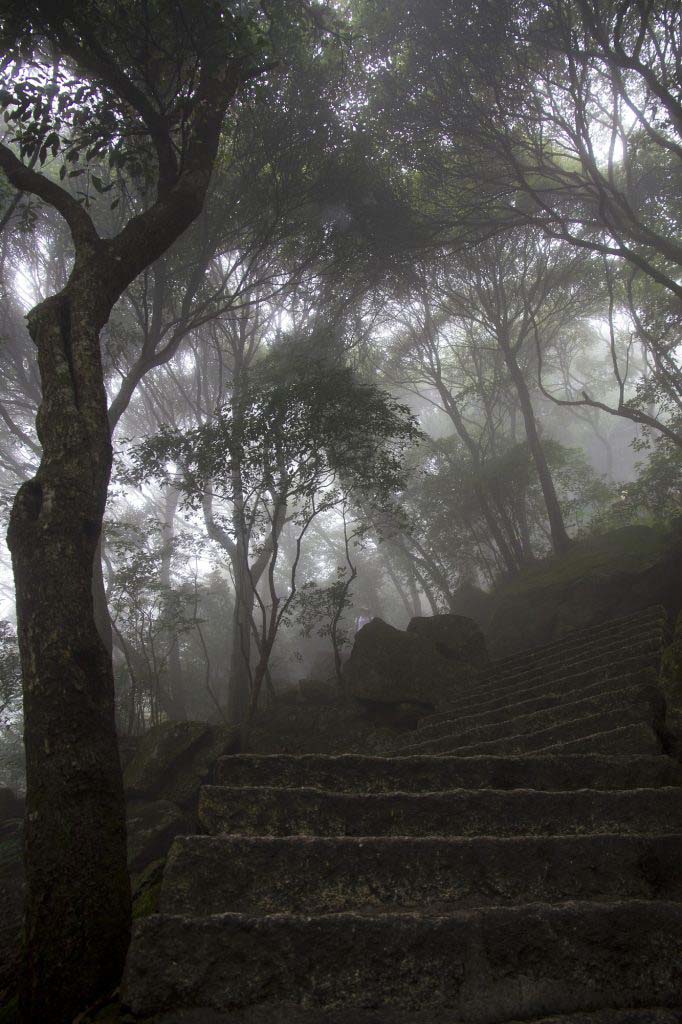
Experiencing Landscape
All in all I spent time within the three different mountain typologies. In this paper I choose a common theoretical framework, as a basis to understand the cultural perception of landscape. I understand now that celebrating Nature became a major preoccupation of the Chinese. To be able to appreciate Nature in its totality it was fundamental for individuals to experience nature consciously by traveling through it. Particularly climbing as high as possible was seen as an ultimate achievement of individual consciousness and aesthetic appreciation.
To enhance the intended progress to (religious) enlightenment and to establish an experience of sublime, beyond beauty, there is a core plot of architectural additions that organize spaces experientially. These elements add significance to particular places along the journey to frame, structure and layer one’s movement to the top. In this way there is a state of harmony; man-made elements that strengthen natural religious characteristics. These characteristic are not only found amongst the most sacred sites, and I found them to be remarkably similar over the three sites I visited. I consider this approach part of the cultural identity in which the Chinese incorporate the perception of landscape as a fundamental value.
From the outset I asked myself whether the proclaimed balance between man and nature, its perception of the environment as a harmonious co-existence, could be a source of inspiration, perhaps a precedent for contemporary interventions within this landscape.
During my traveling to, and through, the three mountains I described above I found there is already a strong change in the perception of recorded historic figures and the contemporary visitor. And naturally this also changes the effects on the perception of landscape. I found this to be strongest at Huangshan, were the experience of transcendence upon reaching the top was replaced by an experience of grounding instead. A reality check; this is contemporary China. People; ugly buildings, litter, noise, picture moments. Although; once you get away from the crowds; once you try the more challenging experiences; up the Western steps; or climbing the Purple Peak; one can still feel as the greatest poets, intellectuals, emperors and monks must have felt when they were before me.
So there is a certain state of schism. Between a challenging reality that defies traditional constituents;a reality that ignores values that have shaped a cultural identity on the one hand and the last remnants of experiences that created these perception throughout history. And this is not only the case of key-landscaping elements such as the great mountains of China. As a contemporary example of changing environments and to describe the current state of harmony ‘closer to reality’ I would like to add the Yongding river, the largest river to flow trough the Beijing municipality as an Epilogue to conclude this paper.
Epilogue: Yongding river change
This river borders the birth place of civilization on the Asian continent, with the Peking Man site in its vicinity, and it is the river that Marco Polo crossed before entering ancient Beijing; by then known for its vigorous current and seasonal floods.
However, over the past thirty or so years, human interventions have led the river to dry out completely. The sprawl of Beijing urbanization, the development of heavy, water-intensive industry and the intensification of agriculture along the river water shed lead to droughts and plummeting ground water levels. Not only are these indirect effects now becoming visible, also the explicit additions of high-voltage power lines, steel factories, power plants and large infrastructural elements destroy any possible experience of the sublime of Natural integrity. This disrespectful approach to one of Nature’s main entities makes you wonder about the harmony I was referring to; as witnessed by a long forgotten ancient pagoda on top of the hill.
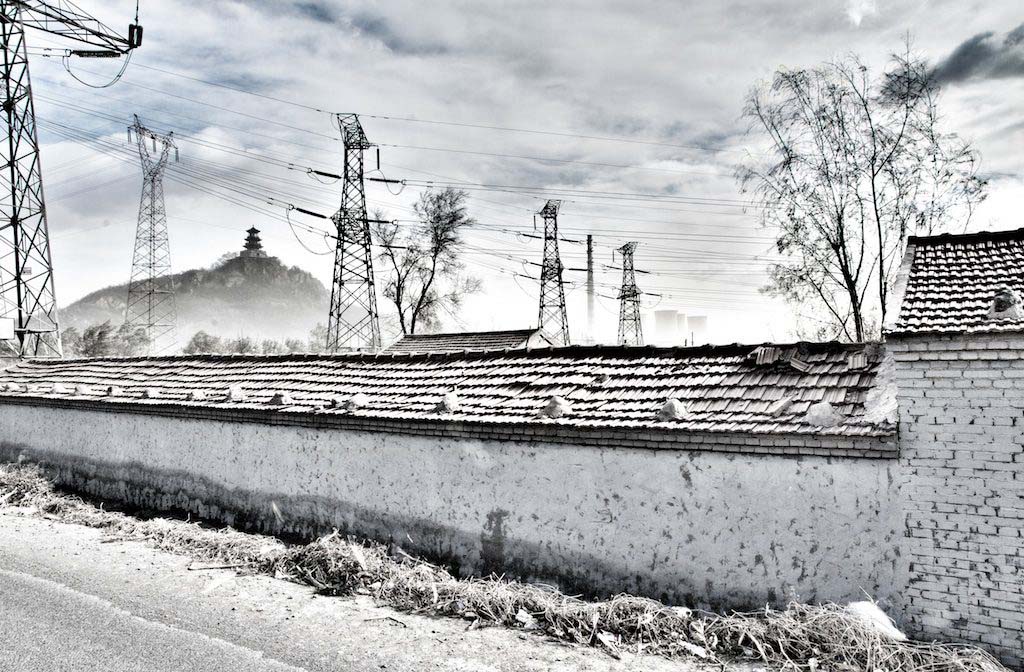
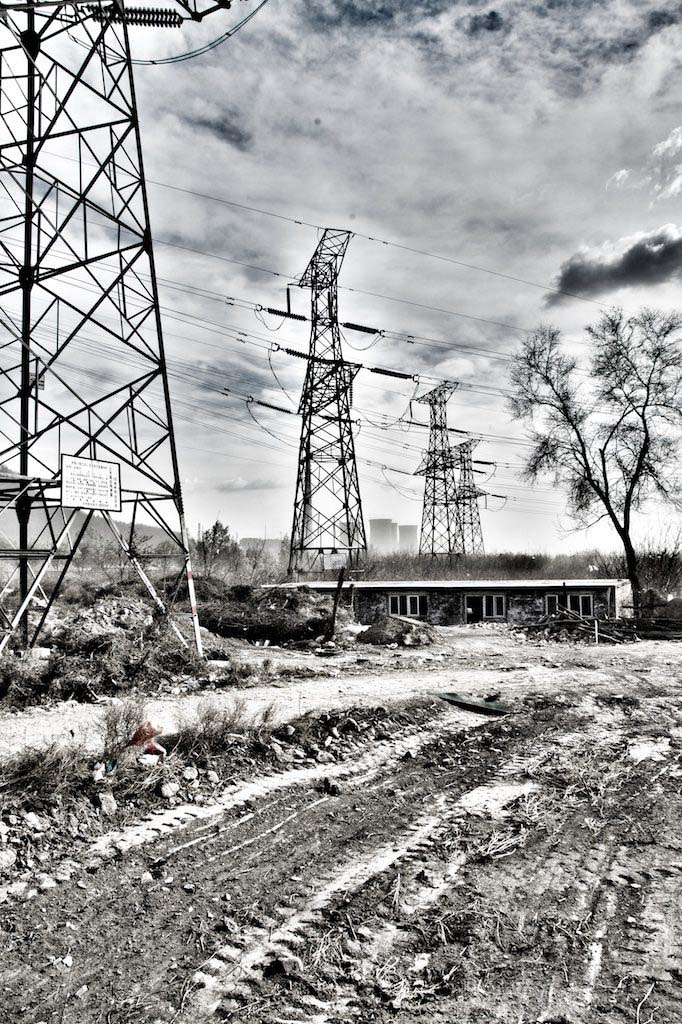
I sincerely believe it is time to critically asses these developments, seen from a cultural-historic perspective, with the meta-physical characteristics in mind, but also in terms of providing an environment for future generations to inhabit.
As architects I think we are capable of shaping the environment we inhabit. We should take responsibility for the way we influence the future of of our habitat around us. As we consider our actions part of an integral network of events; a world in which we are part of a system that is larger then the immediate short-term consequences we can perceive in our short lives; then we can perhaps go back to a state that provides an experience of harmony.
Towards a landscape that inspires; to which one can pledge respect; that brings order; in which you can experience beauty. In which humans are part of a balanced environment.
References
Image credits
All pictures taken by the author, Martijn de Geus, except for the image of Tiantai Temple on page 24, which is taken from Wikipedia.org.
The diagrams on pages 15, 20 and 29 are also taken from creative common licenses found on the internet.
Sources/ quotes
1 Yang, Yongliang, Heavenly City, p38
2 Li, Xiaodong and Yeo, Kang Shua, Chinese Conception of Space, p 14-15
3 http://en.wikipedia.org/wiki/Shanshui
4 Li, Xiaodong and Yeo, Kang Shua, Chinese Conception of Space, p 23
5 Ibid. p 19
6 Ibid. p 21
7 Confucius – The Analects
8 http://en.wikipedia.org/wiki/Five_Sacred_Mountains
9 http://www.maps-of-china.net/tourism_map/h_huangshan.htm
10 http://en.wikipedia.org/wiki/Mount_Hua
11 http://www.chinadialogue.net/article/show/single/en/485-Religion-and-the-environment-in-China
12 Lonely Planet, 2007, p 434
13 see http://www.chinadiscover.net/china-tour/anhuiguide/mount-jiuhua.htm for more info
14 Lonely Planet, 2007, p 446
15 http://en.wikipedia.org/wiki/Huangshan
16 Lonely Planet, 2007, p 448
17 http://www.shanghaifocus.com/beginning-to-believe-peak
18 http://whc.unesco.org/en/list/547
19 Li, Xiaodong and Yeo, Kang Shua, Chinese Conception of Space, p 17
20 Ibid. p 14
21 Yang, Yongliang, Heavenly City, p38
22 Yang, Yongliang, Heavenly City, p26
Bibliography
Li, Xiaodong and Yeo, Kang Shua, Chinese Conception of Space, 2007, ISBN 978-7-112-09192-8, published by Tsinghua University press
Yang, Yongliang, Heavenly City, 2010, published by Galerie Paris-Beijing
Harper, D et al, China , 2007, published by Lonely Planet
Waley, A, Confucius – The Analects, 2000, published by Everyman’s Library
architecture, China, Chinese conception of space, Chinese history, landscape, mountains, nature